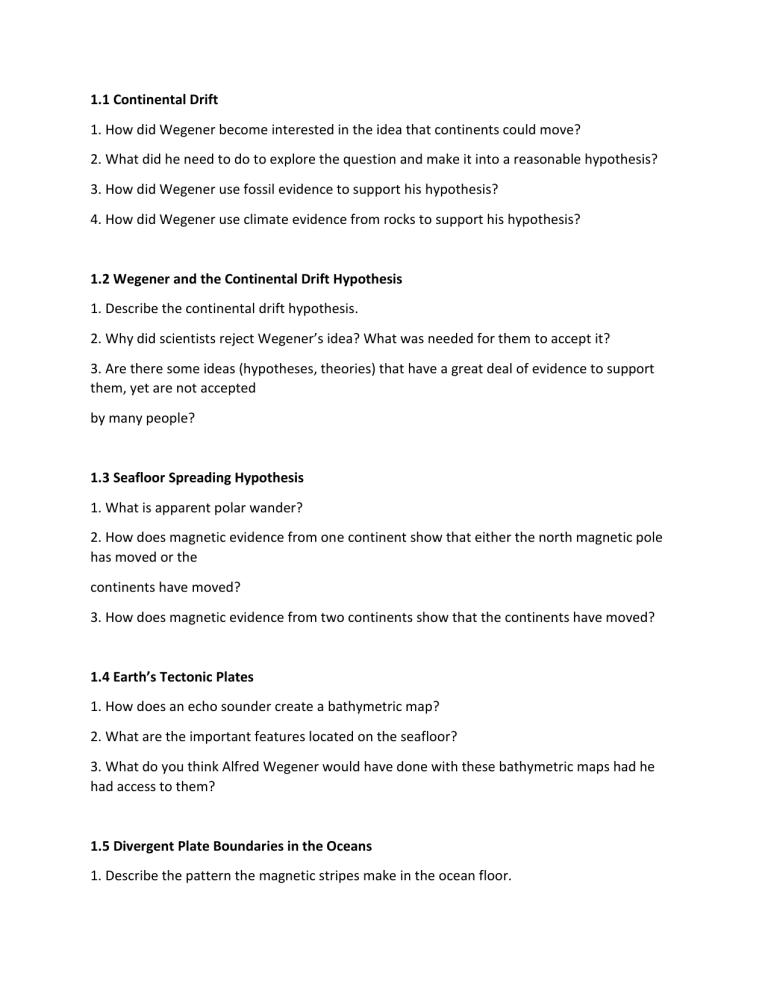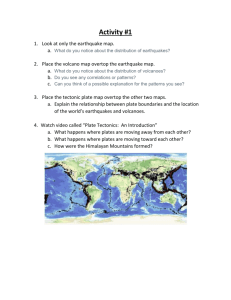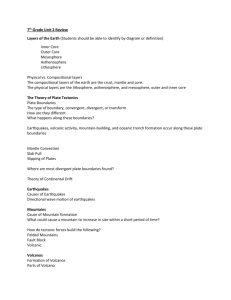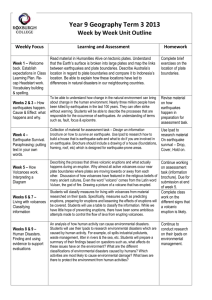Mission_Questions

1.1 Continental Drift
1. How did Wegener become interested in the idea that continents could move?
2. What did he need to do to explore the question and make it into a reasonable hypothesis?
3. How did Wegener use fossil evidence to support his hypothesis?
4. How did Wegener use climate evidence from rocks to support his hypothesis?
1.2 Wegener and the Continental Drift Hypothesis
1. Describe the continental drift hypothesis.
2. Why did scientists reject Wegener’s idea? What was needed for them to accept it?
3. Are there some ideas (hypotheses, theories) that have a great deal of evidence to support them, yet are not accepted by many people?
1.3 Seafloor Spreading Hypothesis
1. What is apparent polar wander?
2. How does magnetic evidence from one continent show that either the north magnetic pole has moved or the continents have moved?
3. How does magnetic evidence from two continents show that the continents have moved?
1.4 Earth’s Tectonic Plates
1. How does an echo sounder create a bathymetric map?
2. What are the important features located on the seafloor?
3. What do you think Alfred Wegener would have done with these bathymetric maps had he had access to them?
1.5 Divergent Plate Boundaries in the Oceans
1. Describe the pattern the magnetic stripes make in the ocean floor.
2. How does magnetic polarity reveal the age of a piece of seafloor?
3. What other indications do scientists have regarding the age of the seafloor in various locations?
1.6 Divergent Plate Boundaries
1. How does the pattern of magnetic stripes give evidence for seafloor spreading?
2. How does the topography of the seafloor give evidence for seafloor spreading?
3. How does seafloor spreading fit into the idea that continents move about on Earth’s surface?
1.7 Transform Plate Boundaries
1. How does the topography of the seafloor give evidence for seafloor spreading?
2. How does seafloor spreading fit into the idea that continents move about on Earth’s surface?
3. How do convection cells drive the plates around Earth’s surface?
4. What are the three types of plate boundaries?
1.8 Ocean-Continent Convergent Plate Boundaries
1. What is the direction of plate motion at a divergent plate boundary?
2. Describe the relationship between the convection cell and volcanism at the mid-ocean ridge.
3. Why is the Leif the Lucky bridge so interesting?
1.9 Ocean-Ocean Convergent Plate Boundaries
1. How is a divergent plate boundary on land different from one in the ocean?
2. What is happening to the Baja California peninsula?
3. How did continental rifting play into the breakup of Pangaea?
1.10 Continent-Continent Convergent Plate Boundaries
1. What is the direction of plate motion at a transform plate boundary?
2. Why are transform faults on continents prone to massive earthquakes?
3. How do transform faults in the oceans compare with those on land?
1.11 Plate Tectonics through Earth History
1. What is the direction of plate motion at a convergent plate boundary?
2. Describe the relationship between the convection cell and subduction at a trench.
3. Subduction is sometimes called crustal recycling. Why do you think this is the case?
4. What happens if magma is too viscous to rise through the crust to erupt at the surface?
1. Compare and contrast the features of an ocean-ocean convergent plate boundary with the features of an oceancontinent convergent plate boundary.
2. How do the Aleutian volcanoes differ from the Cascades volcanoes?
3. How do island arcs get their name?
1. Compare and contrast the features of a continent-continent convergent plate boundary with the features of an ocean-continent convergent plate boundary.
2. What causes mountain ranges to rise in this type of plate boundary?
3. Why are there earthquakes but not volcanoes in this type of plate boundary?
1. Describe the plate tectonics processes that brought Pangaea together.
2. Describe the plate tectonics processes that split Pangaea up.
3. Why do scientists think that there will be another supercontinent in the future?
1. What is a mantle plume and how is it related to a hotspot?
2. How do scientists use hotspot volcanism to tell the direction and speed of a plate?
3. Why are hotspot volcanoes much more common in the oceans than on continents?
2.1 Faults
1. Imagine you’re looking at an outcrop. What features would you see to indicate a fault?
2. If the San Andreas Fault has had 350 miles of displacement, where did the rocks in San
Francisco (on the west side of the fault) originate? How do scientists know?
3. How do you imagine the Grand Teton mountain range rose? In one earthquake? Along one fault? Or is there a more complex geological history?
2.2 Earthquake Characteristics
1. How does elastic rebound theory describe how an earthquake takes place?
2. Where is an earthquake’s focus? Where is its epicenter?
3. Why do shallow earthquakes cause the most damage?
2.3 Earthquake Zones
1. Diagram the western United States with different types of plate boundaries.
2. Why are most earthquakes at plate boundaries?
3. Why are some earthquakes away from plate boundaries?
4. What two types of plate motions occur along the Pacific Rim? Where would you find each type along western
North America?
5. What type of plate motions cause the Mediterranean-Asiatic quakes?
6. Why do earthquakes occur away from plate boundaries?
2.4 Earthquakes at Transform Plate Boundaries
1. Why are earthquakes at convergent plate boundaries sometimes deep, while those at transform plate boundaries are always shallow?
2. Are the earthquakes that take place along the other faults in the San Andreas Fault Zone always smaller than the earthquakes that take place on the San Andreas Fault itself?
3. Do you expect that the quiet along the San Andreas Fault near San Francisco since 1906 means that earthquake activity is calming down along that plate boundary?
2.5 Earthquakes at Convergent Plate Boundaries
1. Why does a subducting plate produce so many earthquakes and what type of quakes does it produce?
2. What caused the most destruction from the 2011 Japan earthquake and why?
3. Why do you think the Pacific Northwest has such infrequent but exceptionally massive earthquakes? There are several possible reasons.
2.6 Intraplate Earthquakes
1. Why do intraplate earthquakes tend to be less frequent and smaller than earthquakes at plate boundaries?
2. Why do intraplate earthquakes take place at all?
3. What causes intraplate earthquakes?
2.7 Predicting Earthquakes
1. Why are earthquakes so hard to predict?
2. Why is it easier to predict where a quake will occur than when?
3. Describe some of the signs that scientists use to predict earthquakes.
4. It’s now nine years after the map of earthquake probabilities in the San Francisco Bay area was made. What do you think the fact that no large earthquakes have struck those faults yet does to the probability that one will strike by
2032?
2.8 Tsunami
1. Why is a wave that is so powerful and tall on land unnoticeable at sea?
2. What should you do if you are at the beach and the water suddenly is sucked offshore?
3. Describe tsunami as waves in the way they travel up a shoreline and may strike as crests or troughs.
2.9 Measuring Earthquake Magnitude
1. Define seismograph, seismogram, and seismometer.
2. What does a seismogram with P-waves but not S-waves mean?
3. How can you tell a main earthquake from foreshocks and afterschocks?
2.10 Locating Earthquake Epicenters
1. How do you determine the distance from the seismograph to the earthquake epicenter?
2. How do you find the epicenter from three seismographs? What if you have more seismographs involved?
3. In what circumstance would three seismographs not give you enough information to find an earthquake epicenter?
2.11 Earthquake Damage
1. In the map of expected Modified Mercalli Intensity for the Bay Area of a hypothetical earthquake on the Hayward
Fault, why do you think there is red and black north of the bay and up the Sacramento River?
Why do you think there are much safer areas in rings around the bay?
2. What causes liquefaction and why is it damaging?
3. If a 9.2 earthquake struck near Anchorage, Alaska today, what do you think the fatalities would be compared with the quake in 1964?
2.12 Earthquake Safe Structures
1. Why do people build structures in earthquake-prone areas like the San Francisco or Los
Angeles areas?
2. Why do fires do so much damage after an earthquake?
3. How do people weigh the costs and benefits to determining how earthquake safe to make structures in an area?
2.13 Staying Safe in an Earthquake
1.What should you do to prepare for an earthquake?
2. What should you do during an earthquake?
3. What should you do after an earthquake?
2.14 Volcano Characteristics
1. Where do most volcanoes occur? Why?
2. What is needed for magma to form?
3. If a volcano is dormant, can it become active? Can it become extinct?
2.15 Volcanoes at Plate Boundaries
1. What causes melting at convergent plate boundaries?
2. Why are there so many volcanoes around the Pacific Ocean basin?
3. What causes melting at divergent plate boundaries?
4. How does a rifting within a continent lead to seafloor spreading?
2.16 Volcanoes at Hotspots
1. What causes melting at a hotspot?
2. Why are there a relatively large number of hotspots in the Pacific Ocean basin?
3. Why do you think there are so many hotspots at mid-ocean ridges; e.g. four along the Mid-
Atlantic Ridge and two at the East Pacific Rise?
2.17 Magma Composition at Volcanoes
1. Why do felsic lavas erupt explosively? Why do mafic lavas erupt effusively?
2. How is magma composition related to viscosity?
3. How does the type of volcano formed relate to the viscosity of the magma that erupts from it?
2.18 Explosive Eruptions
1. Why do convergent plate boundaries have explosive eruptions?
2. Why do felsic magmas erupt explosively?
3. How do volcanic gases affect the atmosphere?
2.19 Effusive Eruptions
1. Why do mafic lavas flow rather than explode?
2. Compare and contrast a’a and pa ̄hoehoe lavas.
3. How do pillow lavas form?
2.20 Predicting Volcanic Eruptions
1. What are the detectable signs that magma is moving beneath a volcano?
2. What are the consequences of incorrectly predicting a volcanic eruption?
3. How would a successful prediction of a volcanic eruption resemble a successful prediction of an earthquake?
2.21 Types of Volcanoes
1. Why do mafic lavas produce shield-shaped volcanoes and felsic lavas produce cone-shaped volcanoes?
2. From what does a composite volcano get its name?
3. Describe how a cinder cone forms.
2.22 Supervolcanoes
1. What is the composition of supervolcano eruptions? Why are these eruptions so massive?
2. What is the source of volcanism for the supervolcano at Yellowstone?
3. How does a supervolcano eruption potentially change the course of life on Earth?
2.23 Volcanoic Landforms
1. What is Shiprock and how did it form?
2. How do lava plateaus form?
3. What types of landforms are created by very viscous magma?







